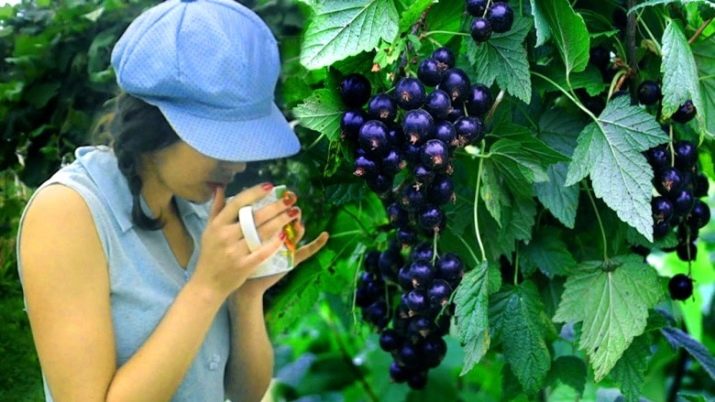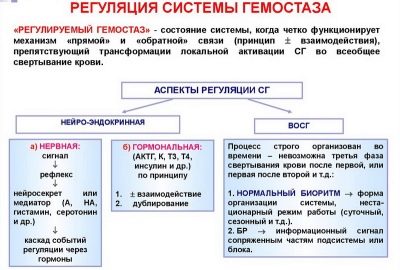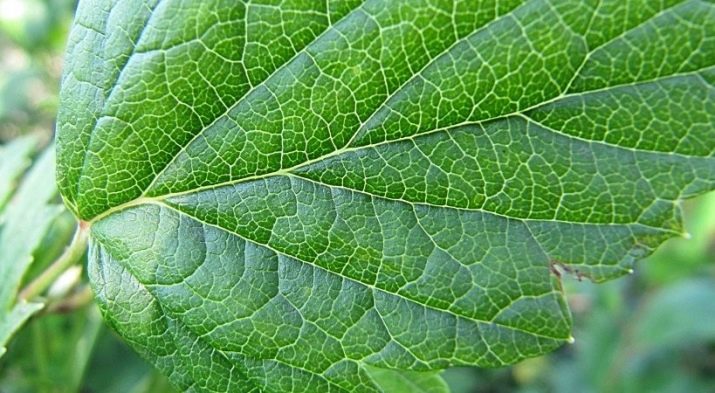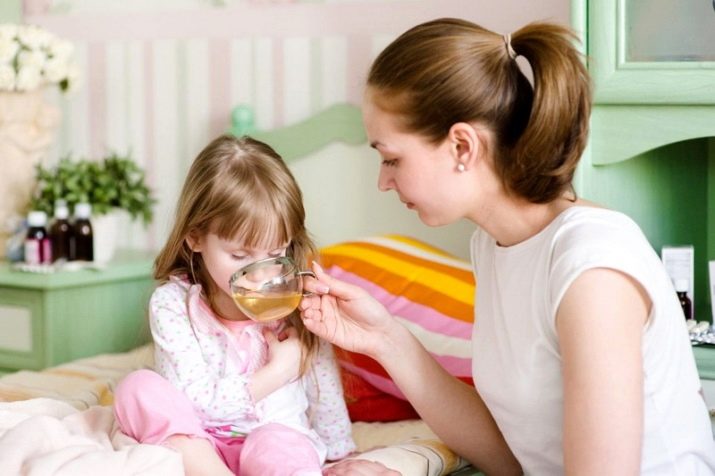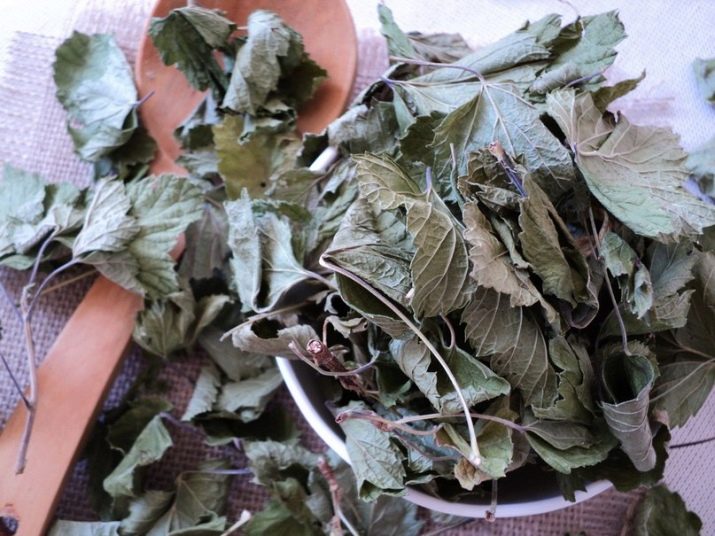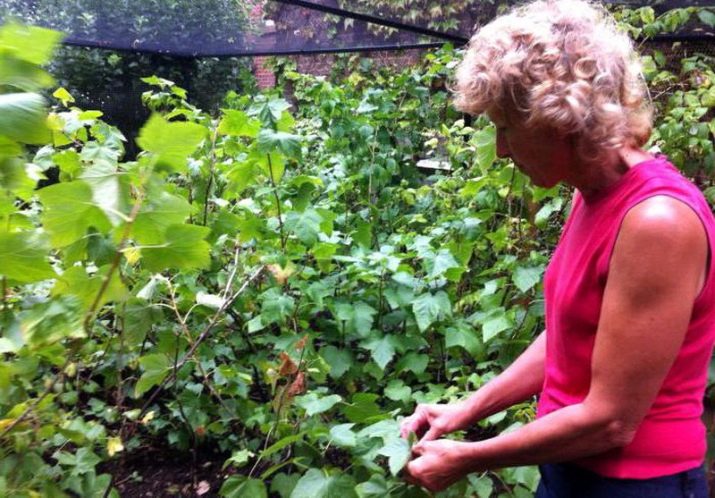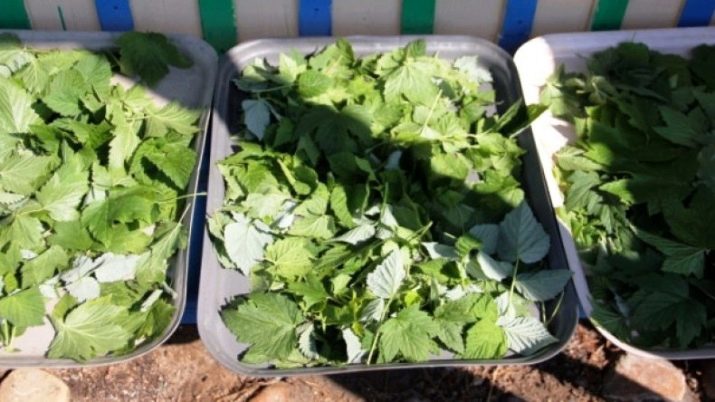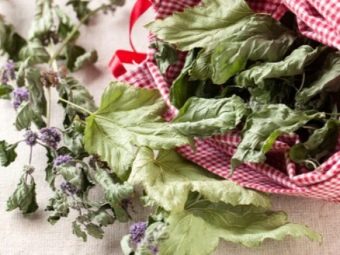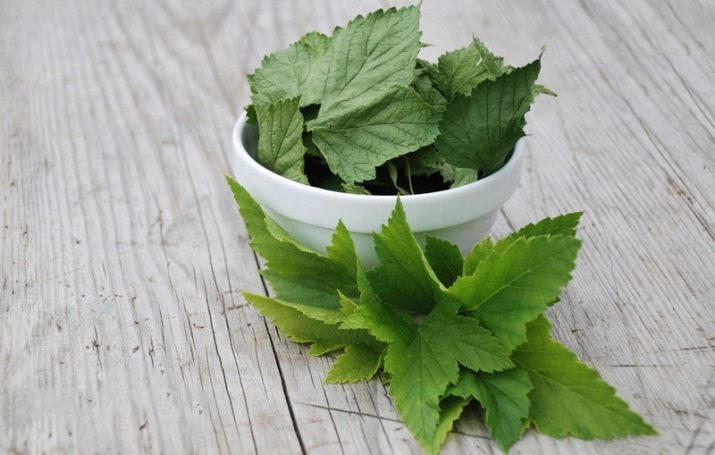Black currant leaves: medicinal properties and contraindications

We strive to find on the shelves of pharmacies the best vitamins for themselves and children, drugs for immunity, despite their considerable cost. Nevertheless, the real top-class medicine grows in almost every garden in all regions of our country. Black currant bushes are unpretentious, do not require careful maintenance, a special approach to growing. They grow and every year they delight us with berries that contain a record amount of vitamin C.
A special place in medicine is given to the leaves of black currant. In this article, we will tell you what their value is, when they should be taken, how to prepare an effective home remedy, without spending the family budget. We will also tell you how to harvest the leaves and how to store them so that they do not lose their properties.
Chemical composition
Black currant leaves are very appreciated by the chefs. They attribute them to the category of spices and flavorings. They are used in canning vegetables, in the preparation of meat dishes, salads, compotes and tea. Calorie content is low - about 56 kilocalories per 100 grams of greens. The leaves of this shrub most carbohydrates - their content reaches 90%. Not less than 8% is allocated to the share of proteins, not more than 1.5% to the share of fat.
Among the nutrients for which humanity appreciates the leaves of black currant, it should be noted "leader" - ascorbic acid. After all the berries are harvested, after a few days the content of vitamin C reaches its maximum - 450-470 mg. In addition, the leaves have a sufficient amount of carotene, volatile production, essential oils. To a small extent are terpene alcohol and phenols.
The vitamin composition of black currant leaves is not so extensive, but each vitamin is presented in a sufficiently large amount. Ascorbic acid is in the lead, followed immediately by vitamins B, A and E. The mineral composition is wide: potassium, calcium, magnesium, sodium, manganese, copper, lead, silver and sulfur. About 4.5% of the total chemical composition is diverted to organic acids - malic and citric.
The composition of foliage of currant (per 100 grams of vegetable raw materials) is presented in more detail in this table:
Vitamins | Macronutrients | Trace elements | The nutritional value |
PP - 0.3 mg | Calcium 36 mg | Iron - 13 mg | Dietary fiber - 4.8 g |
And - 17 mkg | Potassium - 350 mg | Zinc - 0.10 mg | Unsaturated fatty acids - 0.2 g |
B1 - 0.003 mg | Magnesium - 31 mg | Iodine - 1 mcg | Saturated fatty acids - 0.3 g |
B2 - 0.005 mg | Phosphorus - 33 mg | Copper - 120 mcg | Organic acids - 3 g |
B5 - 0.4 mg | Chlorine - 14 mg | Manganese - 0.15 mcg | |
B6 - 0.1 mg | Sulfur - 2 mg | Fluorine - 15 mcg | |
Folic acid - 5 mcg | Boron - 50 mcg | ||
C - 200 - 450 mg | Cobalt - 3 mcg | ||
E - 0.07 mg | Molybdenum - 22 mcg |
Such a chemical set causes incredible and amazing beneficial properties of currant foliage. They were seen in alternative medicine, and were gradually recognized as traditional medicine.
When in the house there is such vegetable raw materials, we can safely say that you have a wonderful spice, and an excellent medicine for many diseases and conditions, if you take it as part of a complex treatment, and a cosmetic drug, and an aromatic additive.
Some people mistakenly believe that there are significantly fewer nutrients in the black currant foliage than in fruits collected from the bushes. This is not true. The composition of the leaves is almost no different from the fruit, in any case, this statement is true for vitamin and mineral composition.
What is useful?
The content of vitamin C in the leaves is higher than in the fruit. This situation is due to the absence of certain enzymes in the leaves, which are present in berries that destroy the structural bonds of ascorbic acid. 100 grams of leaves of a bush content of vitamin C exceeds the daily rate for an adult.
Without this vitamin, the formation of connective tissue and a special substance - collagen would be impossible. That is why vitamin C is called the vitamin of youth, it gives the skin elasticity, healthy color, slows the formation of wrinkles.
In addition to a noticeable cosmetic effect for the human body, vitamin C is involved in the processes of hemostasis. In particular, it takes part in the process of blood coagulation, strengthens the walls of blood vessels - from small capillaries to large main vessels, and also has a pronounced anti-inflammatory effect. That is why currant leaves are often recommended as part of complex therapy for people with atherosclerosis, high blood pressure, vascular diseases.
Healing properties of the effects on the walls of blood vessels for a long time were regarded as antiviral. That is why currant and its leaves were recommended during periods of influenza, ARVI for both adults and children. But recent studies by scientists have shown that vitamin C does not affect the virus, although the fact that it strengthens the vascular walls cannot be ignored. It is this “amplification” that slows down the progress of the virus through the circulatory system.
The main benefit to human health from eating currant leaves, therefore, is to obtain large amounts of vitamin C, which is not produced by the body on its own and must always be “supplied” with food.
Polyphenolic compounds in the composition of black currant leaves provide normalization of metabolic processes in the body. Their presence does not allow the connective tissue to grow pathologically, and therefore the use of shrub leaves is a great way to prevent cancer and metastases after undergoing oncology treatment.
Natural antioxidants help to eliminate toxins, which is why black currant leaves are especially recommended for children and adults living in regions with an unfavorable ecological situation in large gassed cities.
Minerals help strengthen bones, teeth, hair. Magnesium has a positive effect on the state of the nervous system, and therefore drinks from the leaves of black currant are especially useful for children who are in a period of intensive growth.
The combination of magnesium with potassium is considered beneficial for the heart muscle - the leaves of the shrub are used to prevent heart attack. They strengthen the myocardium and contribute to the establishment of an even heart rate. This is especially important in the period of puberty of a child, because, according to statistics, almost every third person in the pubertal period has vegetative-vascular dystonia and arrhythmia.
Black currant leaves are used for compresses and lotions for some skin diseases. Broths from the leaves and vitamin drinks based on them have a tonic effect, and therefore it is especially useful to take them with chronic fatigue, depression, loss of physical and emotional tone. Children can make tea with leaves of black currant during exams or important competitions, when they are under extreme stress.
Folk medicine also attributes to the leaves of black currant antiemetic and antidiarrheal action.
Harm
It would be dishonest to keep silent about the harm that black currant leaves can cause. The above positive effects of a large amount of vitamin C can be dangerous for adults and children with increased acidity of the stomach. Therefore, for gastritis with high acidity, for peptic ulcer disease, some pancreatic pathologies, enzyme deficiency, it is strongly not recommended to take meals, drinks, teas and salads with black currant leaves.
Hepatitis and other liver diseases are also considered to be a weighty contraindication to the use of funds based on this plant material.Any chronic diseases that may occur are also indirect and conditional contraindications. If they are available, take black currant leaves is recommended only with the permission of the attending physician.
Explicit contraindications to receive both the currant itself and its foliage are thrombophlebitis, increased blood clotting, impaired hemostasis in favor of increasing blood viscosity. The coagulation process may become even more intense, leading to the formation of blood clots and the development of thrombosis.
As with any good product or ingredient, with black currant leaves you need to know the measure. Excessive and constant use can lead to impaired hemostasis, to the development of diseases of the stomach and duodenum.
Other contraindications include:
- pregnancy;
- breastfeeding period;
- children up to 2 years;
- the presence of any allergy in history, especially food allergies or related to inadequate immune response to plants;
- individual intolerance.
If a single application of decoction with leaves of currant or tea with them causes discomfort (nausea appeared, heartbeat increased, skin rashes, itching, allergic rhinitis appeared), you should refrain from repeated use.
Application Methods
Apply currant leaves can be outwardly and inward. It all depends on what purpose the person is facing.
Outdoor use
Children and adults can be treated for increased dryness of the skin, as well as acne, making washes and baths with black currant foliage. Children from the year can make baths with this plant raw material for atopic dermatitis, pyoderma (skin abscesses). Anti-inflammatory and antiseptic properties of currant, as well as its rich vitamin and phytoncidal compositions will help to quickly cope with local inflammation, as well as nourish the skin with essential nutrients.
For the face and décolleté, you can brew both fresh and dried currant leaves at the rate of 50 grams of leaves per three liters of hot water. Throwing raw materials into boiling water is not recommended, it is better to wait until the water cools down to 90 degrees - this way, the resulting liquid will be able to preserve the maximum amount of useful substances that are immediately destroyed by boiling.
You can wash the decoction up to three times a day. Soaps and gels, as well as scrubs for such a procedure is not necessary to apply. But their use may be preceded by therapeutic washing. That is, using a currant foliage to wash off already clean and prepared skin.
If currants are used to treat acne in adolescents, you should avoid soap altogether, as in the treatment of prickly heat or diathesis in children under one year old.
Baths for the body are prepared according to the same recipe. But the resulting decoction should be properly dosed - add to the water prepared for bathing a child no more than a liter of currant infusion per 10 liters of water. The dosage for adults may be more concentrated - 2-3 liters of decoction for 10-15 liters of water.
Bath currant leaves belong to the category of phytotherapy. Take them daily can not. For an adult - no more than once in 2 days, for a child - 1 procedure in 3 days. After 10 baths, you should take a break for 1-2 months.
Application inside
Inside, black currant leaves are taken in the form of tea, vitamin drinks, decoction, infusion. Let's look at which forms are most preferable for adults and for children.
Adults can use any drinks with currants, including alcohol tincture (drip). Children alcohol tincture of black currant leaves is contraindicated. Up to 2 years inside the drugs based on this raw material is better not to give. From 2 years old, you can prepare a baby herbal tea of simple composition (only currant leaves), from 3 years old you can prepare complex herbal tea, multicomponent, in which the currant leaves are combined with other medicinal plants and components.
Broth and water infusion of leaves can be given from 2 years, observing the recommended dosages. Vitamin drinks in the absence of allergy, you can prepare the baby also from 2-2.5 years.
Tea from the leaves of black currant is prepared very simply - you can add a leaf to ready and pre-brewed green or black tea, and you can brew herbal tea at the rate of 2-3 leaves per cup. Brew the leaves should be hot, but not boiling water, insist about 5-10 minutes. This tea has a diuretic effect, and therefore is widely used in the treatment of diseases of the urogenital system, as well as in diabetes. Such a drink is very useful for older people with a slow metabolism.
A decoction of foliage of currants is desirable to prepare from dried leaves. Pre-dry raw materials should be crushed. For the broth will need 4 tablespoons of such raw materials and a liter of water. Dry raw materials can be thrown into boiling water or into warm water, then 30 minutes hold in a water bath, cool under a lid, cool, drain. Dosage for adults - up to 200 ml three times a day, for children, depending on age - from 50 to 100 ml three times a day.
Infusion based on water is prepared in a thermos. 4-5 tablespoons of dry leaves are placed in a thermos, poured with a liter of boiling water and infused for several hours. Before use, cool and filter.
Since the infusion is more concentrated than the broth, adults can take 100 ml three times a day, and children - from 20 to 50 ml with the same frequency.
Alcohol based infusion is prepared using fresh leaves. 10-15 leaflets pour 200 ml of alcohol or vodka and insist in a tightly closed container in cool and dark from 14 to 20 days. After that, the infusion can be added to tea (3-5 drops per cup of tea), and you can make antiseptic compresses with it.
Vitamin drink for children and adults can be prepared at any time of the year from fresh or dried leaves. Cooking options there are a great many. Dried raw materials, pre-crushed, used to prepare the decoction, fresh leaves can be put in the drink as a whole. For a child who is weak and often ill, a drink consisting of currant leaves (1-2 pieces), rosehips (4-5 pieces in dried form), and cranberries (10-15 g) is suitable. From this amount of ingredients you can get about two glasses of healthy drink, which can be consumed warm or chilled.
A vitamin drink of currant leaves, lemon and blueberry slices is recommended for a child who does not sleep well, and also to increase his appetite. To improve vision, they make a vitamin drink from currant leaves and blueberries with the addition of carrot and apple juice.
Cooking offers the addition of black currant leaves in the marinade for vegetables. It is the phytoncides that are in the foliage that help to keep cucumbers and tomatoes for a long time intact and intact. You can add finely chopped black currant leaf to any vitamin salad. You can add the leaves in a crushed form in the finished beef goulash, in baked meatloaf.
How to collect and dry raw materials?
The benefits of currant leaves described above will be only if the leaves are properly and timely harvested and stored correctly. After picking berries, the leaves contain the maximum amount of vitamin C, but they become stiff and coarse. Therefore, herbalists recommend collecting leaves at the time of flowering currants. Raw materials at this moment are soft, gentle, suitable for any kind of subsequent use.
The collection should be scheduled for the day when the humidity is high. The best time is between 10 and 12 o'clock in the afternoon, when the morning dew is already dry, but the leaves have not yet had time to heat enough in the sun to lose some elasticity.
The leaves should be taken only from the young shoots of the currant bush, the best of all the branches that appeared no later than a year ago.It should pay attention to the general health of the branch - there should not be signs of fungus or other plant diseases. The branch should not be damaged by insects and caterpillars.
LIt does not need to be washed before drying. The collected raw materials should be laid out on a piece of dry clean cloth and placed in a room that is well ventilated. In the process of drying, do not allow the exposure of the leaves to open sunlight, they must not be in an atmosphere of high humidity.
As soon as the leaves dry (the degree of readiness is checked by rubbing the leaf between the fingers, if the leaf is dry, it easily turns into dust), they should be crushed (but not rubbed!) And poured either into thick linen bags with ties, or into glass cans with tight lockable lids. The harvested currant leaves provide useful properties, provided that they are properly stored and retain up to 2.5 years.
Fresh raw materials are stored in the refrigerator, the maximum shelf life - 7-8 days. Strongly wilted leaves for food and tea should not be used. Some advise to keep frozen. This option is not excluded, but you should know that the leaves in the freezer should be stored no more than 4-5 months. After defrosting, re-freezing vegetable raw materials can not be subjected.
Some believe that fresh leaves can be kept much longer in water, for which they are placed in a jar of water and placed in a refrigerator. This method of storage is not considered correct, because in the aquatic environment the leaves swell and lose most of their beneficial properties.
Bath tubs can be harvested whole currant branches. They are dried in a suspended form in a cool and dark room, and then brewed in full - the leaves along with the branches.
Reviews
Reviews on the use of currant leaves are mainly limited to the culinary use and preparation of tea. Other methods are not so widely used, because most people simply do not have the necessary amount of information about how and for what you can use currant leaves.
To learn how to make tea from the leaves of black currant, see the next video.

